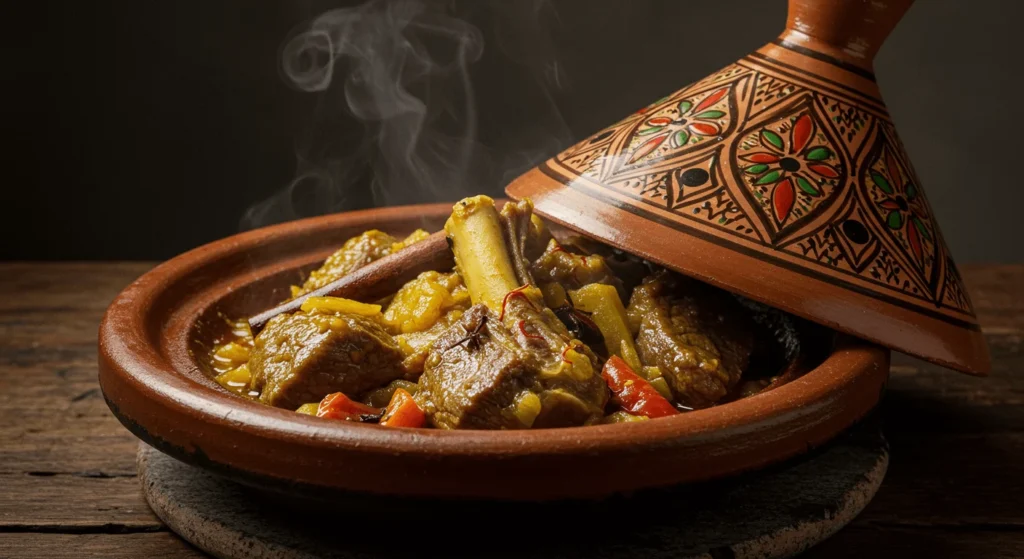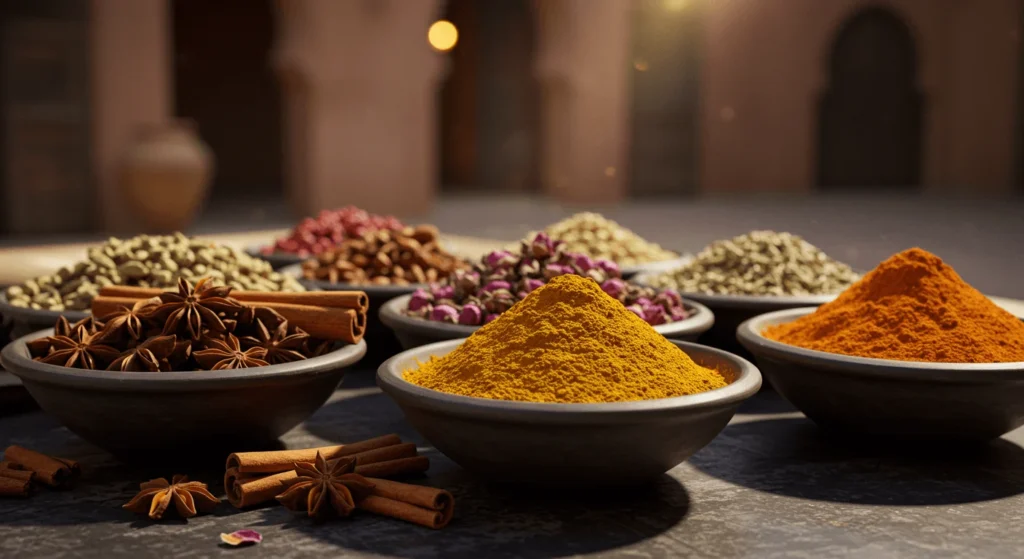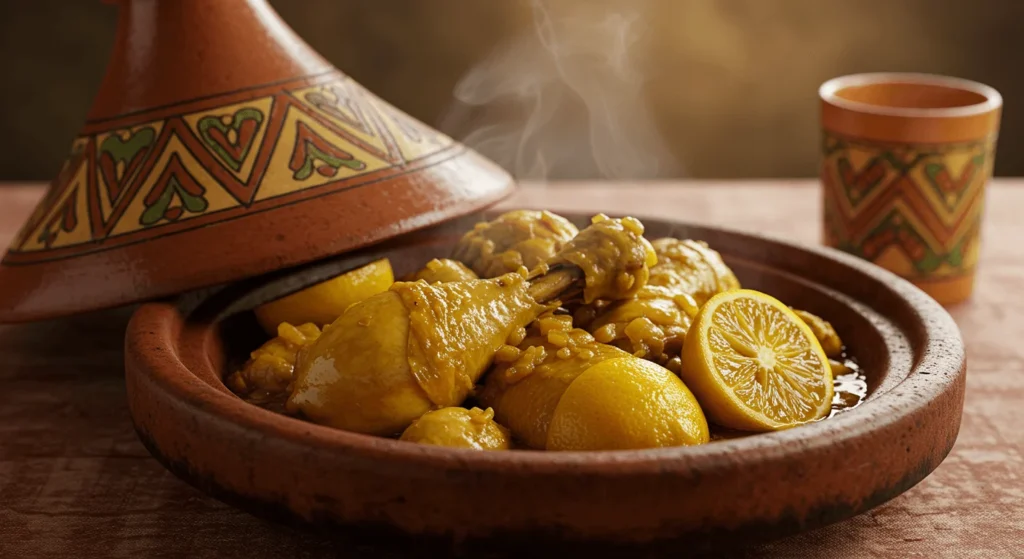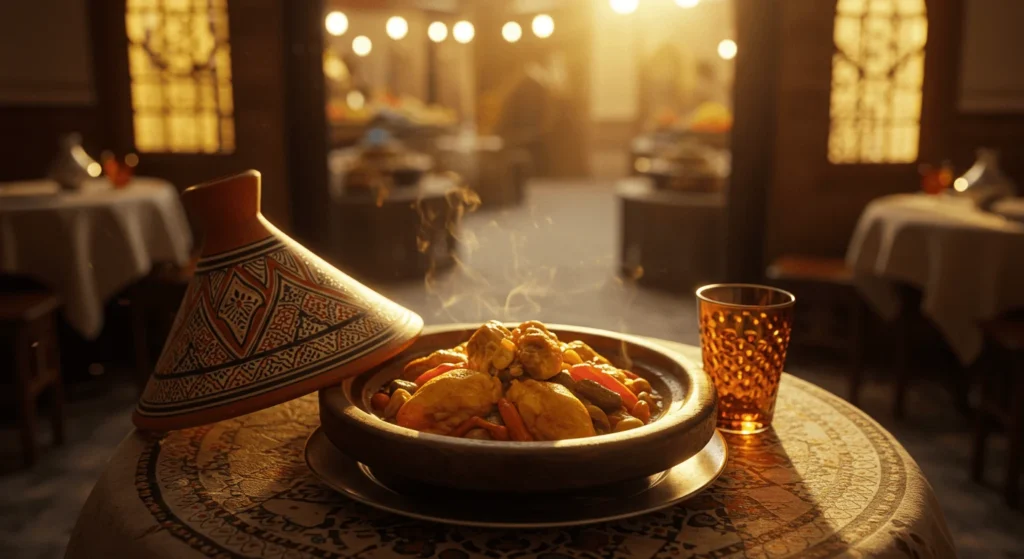Introduction
There’s something magical about Moroccan tagine cooking that transports you straight to the bustling souks of Marrakech. The rich aroma of slow-cooked spices, tender meats, and vibrant vegetables make every bite unforgettable. Yet, crafting the perfect tagine dish can feel overwhelming without the right guidance.
In this blog, we’ll share five simple tips that will transform your tagine creations into flavorful masterpieces. Whether you’re using lamb, chicken, or experimenting with vegetarian options, these tips are tailored to enhance every dish. You’ll also discover how the unique cooking process of a tagine pot unlocks unparalleled depth in flavors.
From layering ingredients to mastering Moroccan spices, these easy-to-follow tips will suit any dietary preference or taste. Whether you’re a seasoned chef or new to tagine cooking, you’re sure to elevate your skills and impress everyone at the table.
Let’s dive in and explore how to make every tagine dish taste truly amazing!
Choose the Right Tagine for Authentic Cooking

The type of tagine pot you use has a huge impact on your dish’s flavor and texture. Choosing the right one ensures you achieve the authentic taste that Moroccan cuisine is known for. Moreover, selecting the proper materials can simplify your cooking process while enhancing the results.
Types of Tagine Pots: Clay, Ceramic, and Cast Iron
There are three main types of tagine pots, each with distinct qualities to suit different needs.
1. Clay Tagines:
- These are the most traditional and widely loved by Moroccan cooks.
- Since they are porous, they allow slow heat distribution, resulting in tender, flavorful dishes.
- For instance, clay tagines work best with recipes like lamb with apricots or chicken with preserved lemons.
2. Ceramic Tagines:
- These modern options often feature vibrant colors, adding visual appeal to your kitchen.
- They retain heat exceptionally well, making them versatile for both stovetop and oven cooking.
- If you love vegetarian dishes, ceramic tagines are perfect for meals like sweet potato and chickpea stew.
3. Cast Iron Tagines:
- Durable and easy to clean, they are great for beginners or busy home cooks.
- Unlike clay, they are non-stick and distribute heat evenly across the surface.
- They’re ideal for experimenting with fusion recipes, such as seafood or tomato-based tagines.
Benefits of Using a Traditional Tagine Pot
Using a traditional clay tagine offers many advantages that elevate your cooking experience.
- Enhances Flavor:
- Because the porous material absorbs and releases spices, it adds depth to the taste over time.
- Locks in Moisture:
- The cone-shaped lid traps steam, keeping dishes moist while intensifying their aroma.
- For instance, slow-cooked beef with prunes benefits from this moisture retention.
- Connects to Culture:
- Cooking in a traditional pot immerses you in the rich heritage of Moroccan cuisine.
- Additionally, it’s perfect for recreating the experience of a Moroccan souk at home.
Tips for Preparing a New Tagine (Seasoning and Maintenance)
Before cooking in a clay tagine, proper preparation ensures its longevity and prevents cracks. Follow these steps:
1. Soak the Tagine:
- Submerge the entire pot in water for 24 hours.
- This process strengthens the clay structure and helps avoid damage during use.
2. Coat with Oil:
- Rub the inside and lid with olive oil, creating a protective layer.
- This step also enhances the natural non-stick properties of the clay.
3. Gradually Heat:
- Place the tagine in a cold oven, then slowly increase the heat to 300°F over two hours.
- Rapid heating can crack the clay, so patience is essential.
4. Cool and Store Properly:
- Allow the tagine to cool completely before cleaning or storing it.
- Always clean with mild soap and warm water to preserve its surface.
By maintaining your tagine well, you’ll ensure it lasts for years and continues to deliver amazing flavors.
With the right tagine pot, you can unlock the authentic essence of Moroccan dishes while enjoying their cultural richness. Whether you choose clay, ceramic, or cast iron, each type offers unique advantages that suit different preferences. Preparing and caring for your tagine will make every dish a delight for your taste buds.
Master the Art of Layering Ingredients in Your Tagine

Layering ingredients correctly in a tagine is essential to achieving the bold and complex flavors Moroccan cuisine is known for. The art of layering not only ensures even cooking but also enhances the fusion of spices, juices, and textures in your dish. By understanding the importance of layering and following a proven method, you can elevate every tagine dish you prepare.
Why Layering is Key to Tagine Flavors
Layering ingredients in a tagine is much more than a cooking technique; it’s the foundation of its signature flavors. Proper layering allows each component to cook evenly, ensuring that the flavors meld harmoniously. For instance, layering ensures that proteins soak up the spices and juices from the aromatics beneath them. This technique also protects delicate vegetables on the top from overcooking.
Additionally, layering supports the unique cooking style of a tagine pot. As the lid traps steam, the ingredients at each layer slowly release their flavors, which are absorbed by the other layers. For example, onions and garlic at the base create a savory foundation, while fruits like apricots or prunes on the top infuse a sweet, aromatic twist. Without proper layering, the dish risks uneven cooking and a less balanced flavor profile.
The Correct Order: Aromatics, Protein, and Vegetables
To achieve the best results in a tagine, follow this layering method:
1. Aromatics at the Bottom:
Begin by placing a layer of aromatics like sliced onions, minced garlic, and chopped herbs such as parsley or cilantro at the base of the tagine. This layer prevents the protein from sticking and burns while infusing the dish with a rich, savory aroma.
2. Protein in the Middle:
Arrange the protein, such as chicken, lamb, or fish, directly on top of the aromatics. Coat the protein with your spice mix, such as ras el hanout, cumin, or paprika, to ensure the flavors penetrate the meat as it cooks. For vegetarian tagines, hearty ingredients like chickpeas or lentils can substitute the protein layer.
3. Vegetables and Fruits on Top:
Place sturdier vegetables, like carrots and potatoes, in a circle over the protein. Add softer vegetables, such as zucchini or tomatoes, toward the center or top. Finish with sweet additions like dried apricots, prunes, or preserved lemons to introduce layers of sweetness and acidity. This placement keeps fragile ingredients from disintegrating during cooking.
This order not only guarantees even heat distribution but also creates a visually appealing dish when served directly from the tagine.
Tips for Ensuring Even Cooking in a Tagine
Achieving perfect results in a tagine requires attention to detail during the layering and cooking process. Begin by cutting vegetables into uniform sizes to ensure they cook evenly. Large, dense vegetables like potatoes or turnips may need to be sliced thinner to soften at the same rate as other ingredients.
Additionally, avoid overcrowding the tagine, as this can prevent the steam from circulating effectively. For larger meals, consider using a wider tagine or cooking in batches. To further promote even cooking, cook on low to medium heat, allowing the ingredients to simmer gently. This gradual process not only prevents burning but also allows the flavors to meld together.
Another helpful tip is to resist stirring the ingredients while cooking. Instead, let the layers remain intact, allowing the natural juices to flow between them. If you need to adjust the dish, tilt the tagine slightly to redistribute the liquid without disturbing the layers.
Finally, make sure to add just enough liquid, such as water, broth, or tomato sauce, to create steam but not overwhelm the ingredients. The steam generated inside the tagine will do most of the cooking, so a small amount of liquid goes a long way.
Mastering the art of layering ingredients in your tagine is key to unlocking the dish’s full potential. By understanding the role of each layer, following the correct order, and applying simple techniques for even cooking, you can create flavorful and visually stunning tagine dishes that leave a lasting impression.
Use Authentic Moroccan Spices to Enhance Flavor

Moroccan cuisine is celebrated for its bold and aromatic flavors, and spices are at the heart of every perfect tagine. Using the right combination of authentic spices not only enhances the taste but also captures the essence of Moroccan cooking. By understanding which spices to use, how to balance them, and techniques like toasting, you can elevate your tagine dishes to new heights.
Essential Spices for a Perfect Tagine (e.g., Ras el Hanout, Saffron)
To create an authentic Moroccan tagine, start with the essential spices that define its distinctive flavor profile.
One of the most important is Ras el Hanout, a spice blend that translates to “top of the shop.” It typically includes up to 30 spices, such as cinnamon, cumin, coriander, ginger, and turmeric. This blend provides a warm, slightly sweet, and earthy flavor that forms the backbone of many Moroccan dishes.
Saffron, often referred to as “red gold,” is another key ingredient for its subtle floral notes and vibrant color. Even a pinch of saffron can transform a chicken tagine or seafood tagine into an elegant and aromatic meal.
Other staples include paprika, which adds a smoky sweetness, and ginger, known for its warm and slightly peppery flavor. Don’t forget cinnamon, used both for its sweetness in lamb tagines with prunes and its depth in vegetable-based recipes.
For those who enjoy experimenting, incorporate spices like caraway or fenugreek for a unique twist. These add layers of complexity without overwhelming the dish’s traditional character.
Balancing Spices and Herbs for Maximum Flavor
Balancing spices is essential to ensure that no single flavor overpowers the others. The goal is to create harmony in every bite.
When using bold spices like cumin or coriander, pair them with lighter notes from fresh herbs like parsley or cilantro. For example, if you’re preparing a lamb tagine, balance the richness of the meat with the brightness of herbs and the sweetness of cinnamon.
Another tip is to layer flavors gradually. Begin by rubbing your protein with a spice mix, ensuring even coverage. Then, sprinkle additional spices like paprika or turmeric over the vegetables to create depth. This layering technique allows the flavors to infuse each component during the cooking process.
Acidity is also important for balance. Ingredients like preserved lemons or a splash of citrus juice help cut through the richness of spices, providing contrast. Similarly, sweet elements such as honey, dried apricots, or raisins can complement the heat of ginger or the earthiness of saffron.
How to Toast Spices for a Deeper Aroma
Toasting spices is a simple yet powerful technique to amplify their flavor and aroma. It enhances the natural oils within the spices, making them more vibrant and aromatic.
Begin by heating a dry skillet over medium heat. Add whole spices like cumin seeds, coriander seeds, or cinnamon sticks, and stir them gently. Toast for one to two minutes, or until you smell a rich, nutty aroma. Be careful not to burn them, as this can lead to bitterness.
For ground spices, use the same method but reduce the toasting time to 30 seconds. Ground spices toast more quickly and require constant stirring to avoid scorching. Once toasted, remove the spices from the heat immediately and let them cool.
If you’re using whole spices, grind them using a mortar and pestle or a spice grinder for maximum freshness. For example, freshly ground cumin or coriander can elevate a chicken tagine with preserved lemons. Store the toasted spices in an airtight container to retain their flavor for future use.
By using authentic Moroccan spices, balancing their flavors, and incorporating techniques like toasting, you can unlock the full potential of your tagine. These steps ensure that every dish bursts with aroma, color, and taste, offering an unforgettable culinary experience.
Cook Low and Slow for the Best Tagine Results

The magic of a tagine lies in its slow, gentle cooking process, which allows flavors to develop fully and ingredients to soften to perfection. This method not only creates depth in your dishes but also ensures the protein and vegetables absorb the rich, aromatic spices. By embracing the “low and slow” technique, you can consistently achieve tender, flavorful tagines that leave a lasting impression.
Why Slow Cooking is Crucial for a Tagine
Slow cooking is the foundation of authentic Moroccan tagines. The conical shape of the tagine’s lid traps steam, which circulates and cooks the ingredients evenly. This process ensures that flavors meld together over time, producing a dish that’s rich and aromatic.
For proteins like lamb or chicken, slow cooking breaks down connective tissues, resulting in meat that is tender and juicy. Vegetables, especially root varieties like carrots and potatoes, benefit from the gradual cooking as they absorb the spices and retain their shape.
Moreover, the low temperature preserves the delicate balance of spices like saffron and cinnamon, which can become bitter if exposed to high heat. By taking your time, you allow each ingredient to contribute to the overall complexity of the dish.
Controlling Heat Levels on Stovetop or Oven
To achieve perfect results, maintaining consistent heat is essential. On a stovetop, use the lowest heat setting possible to prevent burning. A stovetop heat diffuser can help distribute heat evenly across the base of the tagine, minimizing hotspots.
If using an oven, preheat it to 275°F to 300°F. Place the tagine on the middle rack to ensure even cooking. For best results, avoid opening the lid frequently, as this releases the steam necessary for the slow-cooking process.
Add liquid, such as broth or water, in small amounts at the start of cooking. The steam generated inside the tagine will cook the ingredients gently, so avoid overloading it with liquid, which can dilute the flavors.
Common Mistakes to Avoid (e.g., Cooking Too Quickly)
Rushing a tagine is one of the biggest mistakes you can make. High heat can cause the clay pot to crack or the ingredients to cook unevenly. Proteins may become tough, and vegetables could disintegrate into mush.
Another common error is adding too much liquid. Since the steam is trapped within the tagine, excess liquid isn’t necessary and can result in a watery dish.
Finally, avoid skipping the preheating step if using a clay tagine. Gradually warming the pot prevents sudden temperature changes that might cause cracks.
Experiment with Ingredients to Create Unique Tagine Dishes

Tagines are incredibly versatile, allowing you to explore endless combinations of ingredients. Whether you prefer traditional proteins or plant-based options, experimenting with ingredients can lead to delicious discoveries. Adding a balance of sweet and savory flavors will further elevate your dish.
Popular Protein Choices: Lamb, Chicken, and Fish
Lamb is a classic choice for tagines, offering a rich, succulent base that pairs well with spices like cinnamon and cumin. For example, lamb tagines with prunes or apricots provide a satisfying mix of sweet and savory.
Chicken is another popular option due to its ability to absorb spices and cook quickly. A chicken tagine with preserved lemons and olives is a staple in Moroccan cuisine, delivering bold and zesty flavors.
Fish tagines are perfect for lighter meals. White fish such as cod or sea bass works beautifully with a tomato and bell pepper sauce spiced with paprika and garlic.
Vegetarian and Vegan Tagine Ideas
Vegetarian and vegan tagines are equally satisfying and full of flavor. Chickpeas and lentils are excellent protein sources, offering a hearty texture when combined with root vegetables like sweet potatoes or turnips.
Eggplants, zucchini, and bell peppers also work well, especially when paired with tomatoes and spiced with turmeric and coriander. To add depth, incorporate preserved lemons or a touch of harissa for heat.
For a nutty twist, toss in toasted almonds or pine nuts. These ingredients add both flavor and texture, making your plant-based tagines even more exciting.
Adding a Sweet and Savory Twist with Fruits and Nuts
Balancing sweet and savory flavors is a hallmark of Moroccan tagines. Dried fruits like apricots, figs, and dates bring natural sweetness, while nuts such as almonds or walnuts provide a delightful crunch.
For example, a lamb tagine with prunes and almonds combines earthy, sweet, and nutty elements. Similarly, adding golden raisins to a vegetarian tagine enhances the dish with bursts of sweetness.
To amplify the savory side, consider using preserved lemons or olives, which complement the sweetness of the fruit. A drizzle of honey can also round out the flavors, creating a harmonious blend that satisfies every palate.
By cooking low and slow and experimenting with ingredients, you can create tagine dishes that are both traditional and innovative. These techniques ensure every meal is a flavorful masterpiece, offering endless possibilities for customization and enjoyment.
Conclusion
Mastering the art of making an amazing tagine is easier than you think when you follow the right techniques. By choosing the right tagine pot, layering ingredients correctly, using authentic Moroccan spices, cooking low and slow, and experimenting with unique ingredients, you can elevate every dish to a culinary masterpiece. Each of these tips contributes to the depth, aroma, and flavor that make Moroccan cuisine a global favorite.
As you prepare your next tagine, take a moment to reflect on how these methods transform simple ingredients into extraordinary meals. Imagine the rich aroma of Ras el Hanout wafting through your kitchen or the vibrant colors of slow-cooked vegetables infused with saffron. These small details make every dish an unforgettable experience for you and your loved ones.
We encourage you to try these tips in your next tagine creation. Whether you’re a seasoned chef or a beginner, these techniques will help you create dishes that capture the authentic essence of Moroccan cooking. Don’t be afraid to experiment, adding your own twists with proteins, vegetables, or a sweet and savory combination of fruits and nuts. Every tagine tells a story, and now, you’re ready to write yours.
If you’re curious to learn more about the richness of Moroccan cuisine and why it’s celebrated worldwide, check out our blog post: Why Moroccan Cuisine is Number 1 in the World. From the delicate balance of spices to the cultural traditions surrounding every meal, Moroccan food is more than just sustenance—it’s an art form.
Click the link to discover the secrets behind the world’s most flavorful cuisine. Let the journey into the world of Moroccan food continue, one dish at a time!

